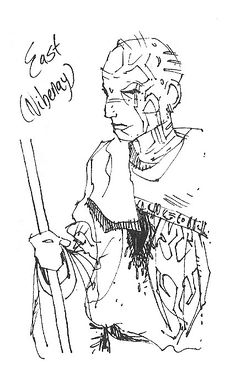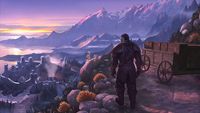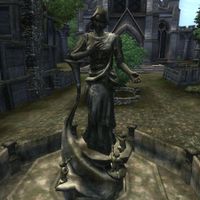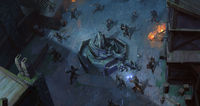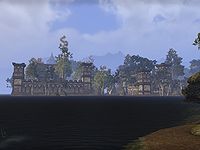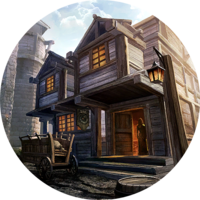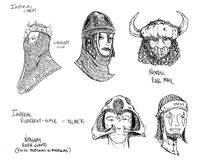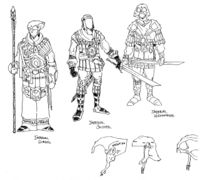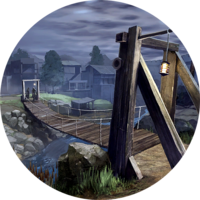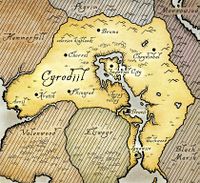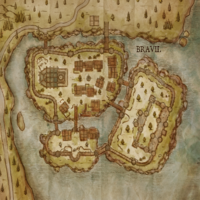Lore:Bravil
| This page is currently being redesigned for the Lore Places Project (LPP). The page may need work to meet the standards outlined on the project page. |
| Bravil | |
|---|---|
| Type | Settlement |
| Continent | Tamriel |
| Province | Cyrodiil |
| Region | Nibenay Valley |
| Demonym(s) | Bravilian |
| Appears in | Oblivion, ESO, Legends |
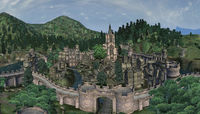
Bravil is a Nibenese city located on the banks of the Niben Bay, south of the Imperial City. It is found in the Nibenay Valley, was said to be historically a tropical region enclosed by an equatorial rain forest and broken up by rivers.[1] The Larsius River passes through and wraps around the town, as the Green Road curves around it. A remarkably large Ayleid settlement is found underneath the city.[2] The symbol of the city is the wild stag.[3]
Under Marukhati rule, cities of the Nibenay Valley were forced to become mercantile magocracies, allowing them to be wealthiest city-states in the region throughout the First Era.[1] In the Second Era, Bravil was built in a unique Nibenese architectural style.[4] By the Third Era, Bravil was a squalid town described as one of the poorest in Cyrodiil[5] with houses built like shacks, being wooden and stacked upon each other. The Larsius River that runs through the town serves as Bravil's sewers. Because of its location on the bay's shore and the marshes and swamps that surround it, the climate is damp.
History[edit]
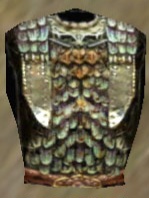
It is known that Ayleids once lived in the region before Bravil was established. The Niben provided food and transportation, and their settlement flourished as a result of increased trade after the establishment of the great White-Gold Tower, being even more populous than Bravil is today.[2][6] The Alessian Army attacked the Ayleids in the First Era, the army being led by the Empress Alessia's centurion Teo Bravillius Tasus.[6] After discovering the Ayleid's ability to use Alteration type magic to defend themselves, Tasus managed to defeat them. Because of his success, the town owes its name to Tasus.[6] It is unclear when exactly the modern city itself was founded. At some point after 1E 700,[7][8] the mortal Dunmer precursor to the Night Mother lived in a predecessor town at the future site of the city, but it is unknown if it was called Bravil at this time.[9] The main city itself has been in existence since at least 1E 1152.[10]
Restrictions imposed by the Alessian Order against certain kinds of meat-eating and animal cults soon made agriculture and husbandry nearly impossible, and as a result, many of the Eastern Imperials were forced to become merchants, soon allowing the Nibenay Valley to become the wealthiest city-state in the region. Despite this, the rich and powerful merchant class were still forced to pay tithes to the Alessian priesthood, reminding them of their status of tenanted citizens. The War of Righteousness ended Alessian rule in 1E 2321, and control of the Nibenay Valley reverted to a mercantile-magocracy, which the western Colovians still thought far too arcane to consider a reunification of Cyrodiil.[1]
In 2E 581, Flaccus Terentius dreamed that an army of Daedra and a legion of the undead under Molag Bal would raze Bravil and destroy all of Cyrodiil. In this dream, Bravil would be defended by the Fourth Legion. It is unknown if these events actually occurred.[11] When the Dark Anchors fell in the Imperial City, Captain Jena Apinia had her legion flee the city and go to Bravil, asking the mayor for help. He refused, and the citizens rioted against Captain Apinia, resulting in her slaughtering many of them and looting the Castle, earning her the title the Butcher of Bravil.[12][13]
County Bravil became independent from the Empire following the Oblivion Crisis of 3E 433. Bravil was often at odds with Leyawiin, which had also gained independence, until the two counties were subdued by Emperor Titus Mede.[14] During the Great War, Dominion invasion forces coming out of Elsweyr and flanking Imperial defenses along the Valenwood border sieged the City after the fall of Leyawiin. It was soon overtaken and controlled by Dominion forces. The City was used as a base for a counterattack by the Dominion against Nordic Legions under the command of General Jonna.[15]
By the 27th of Hearthfire, 4E 188, the city had erupted into violence due to a war of control being waged by Cyrodiil's two largest skooma traffickers. The Listener of the Dark Brotherhood, Alisanne Dupre, was forced to employ sellswords to protect her private residence in the city. By the 4th of Sun's Dusk, things in Bravil had come to a head and the statue of the Lucky Old Lady was destroyed. On the 1st of Sun's Dusk Alisanne Dupre abandoned her residence to defend the Night Mother's crypt. Rasha, the apparent leader of the Cheydinhal sanctuary, sent Garnag and Andronica to Bravil to aid her. After Garnag and Andronica left and the Cheydinhal Sanctuary didn't receive any communication from the city for nineteen days, the remaining members feared the worst. Those fears were realized on the morning of the 21st, when Garnag returned alone with the stone coffin of the Night Mother. Garnag told that the crypt of the Night Mother was raided, Andronica cut to pieces, and Alisanne Dupre was burned alive in a storm of mage fire. Garnag managed to fend off the attackers and transport the coffin safely out of the city, though he got gravely injured and was likely to lose his right eye.[16]
Around the 18th of Morning Star, 4E 201, Daynas Valen became wanted in the city when he killed a collector in possession of the Ivory Claw. He fled for three days of nonstop riding to escape his pursuers, taking a ship in Anvil to Solitude.[17]
Known Rulers[edit]
- Second Era
- Unknown Mayor of Bravil[18]
- Third Era
- Count Regulus Terentius (ca. 3E 433)
The Lucky Old Lady[edit]
The Lucky Old Lady was a statue which once stood in a square east of Bravil's Great Chapel of Mara.
No one knows when the statue to her was erected, or who the artist was, but it has stood there for thousands of years, since the first era. A story printed in the book Daughter of the Niben relayed the story of a woman born into poverty, who became famous for her kindness and charity. When she was a child, a priest soothed her woes of not knowing the identity of her father by telling her she was the daughter of Stendarr, "the God of Mercy, Charity, and Well-Earned Luck". After this encounter she took to referring to herself as a "child of Luck" when asked about her parentage. For showing kindness to an incognito prince who was stripped of his senses after being kidnapped and cursed by witches, she was rewarded with countless riches after he recovered from his ordeal. She shared her great wealth with the rest of Bravil, and lived to an old age. Before the statue was destroyed by rioters in 4E 188[16] people would visit the statue to ask the Lucky Old Lady her blessing of luck.[6]
In actuality, the statue's true purpose was to act as a conduit for the Night Mother to the Listener of the Dark Brotherhood, and was built over her crypt. [19][20] After the destruction of the statue, the Night Mother's remains were removed and ultimately sent to a Dark Brotherhood chapter in Skyrim.[21][22]
Gallery[edit]
Notes[edit]
- The Daughter of the Niben says what the Ayleids called their region around Bravil would be translated to simply mean "home", which is "Math" (or sometimes "Hame") in Ayleidoon.[6]
- Because the Imperial Palace in Arena serves as the final dungeon in the game, Palace quests in the Imperial Province are inaccessible. However, fourteen random quest dungeon icons are present through a toggle but cannot be accessed. One of these dungeons happens to be located right where Bravil is located south of the Larsius River and west of the Panther River.[23]
- There are a number of culinary dishes and drinks that are from Bravil, with known dishes being Bravil's best beet risotto and Bravil melon salad. There are also two known drinks, Bravil mead and Bravil bitter barley beer.
See Also[edit]
- For game-specific information, see the Oblivion, Elder Scrolls Online, and Legends articles.
Books[edit]
- Daughter of the Niben by Sathyr Longleat — The history of Bravil and its famous statue of the Lucky Old Lady
References[edit]
- ^ a b c Pocket Guide to the Empire, 1st Edition: Cyrodiil — Imperial Geographical Society, 2E 864
- ^ a b Ayleid Cities of Valenwood — the Esteemed Historian Homfrey at the University of Gwylim, 2E 455
- ^ Gathering Force: Arms and Armor of the Imperial Champion; Hall Steward Longinus Attius
- ^ Appearance in ESO
- ^ Guide to Bravil — Alessia Ottus
- ^ a b c d e Daughter of the Niben — Sathyr Longleat
- ^ Pocket Guide to the Empire, 1st Edition: Hammerfell — Imperial Geographical Society, 2E 864
- ^ The Battle of Red Mountain — Vivec
- ^ The Night Mother's Truth — Gaston Bellefort
- ^ Imbel Genealogy
- ^ The Improved Emperor's Guide to Tamriel: Dreams of Cyrodiil — Flaccus Terentius, 2E 581
- ^ The Butcher of Bravil — Captain Jena Apinia
- ^ Razum-dar's dialogue during Debts of War in ESO
- ^ The Infernal City — Greg Keyes
- ^ The Great War — Legate Justianus Quintius
- ^ a b Cicero's Journal - Volume 2 — Cicero
- ^ Daynas Valen's Journal — Daynas Valen
- ^ The Butcher of Bravil — Captain Jena Apinia
- ^ The Crypt of the Night Mother
- ^ Arquen's dialogue during Honor Thy Mother
- ^ The conclusion of The Fall of the Dark Brotherhood
- ^ The Night Mother in Skyrim
- ^ Map of Unused Dungeons in the Imperial Province – The Elder Scrolls: Arena
